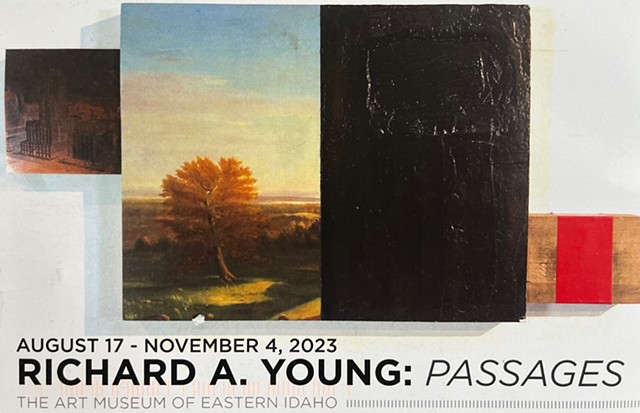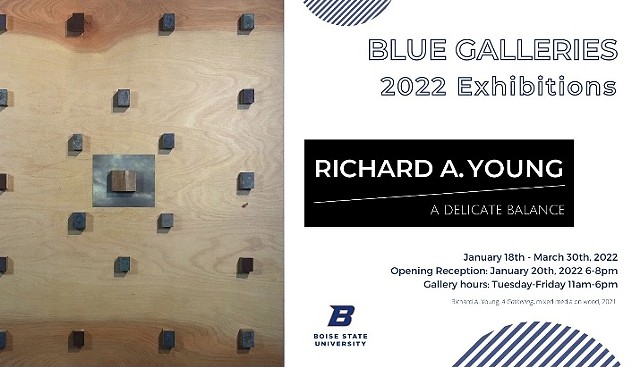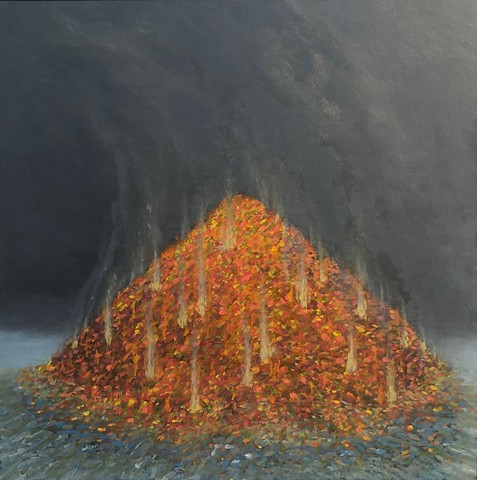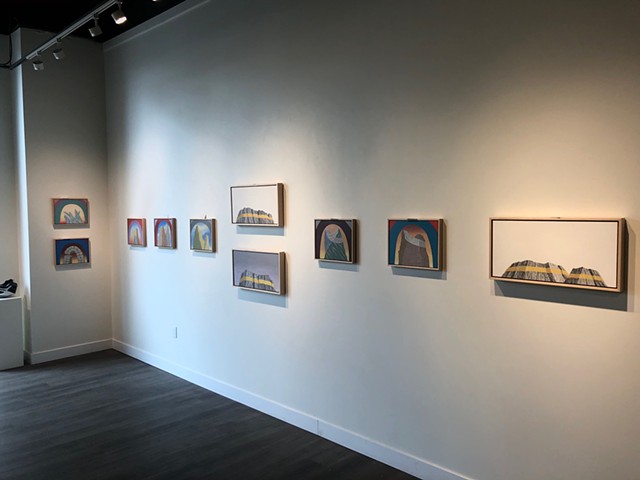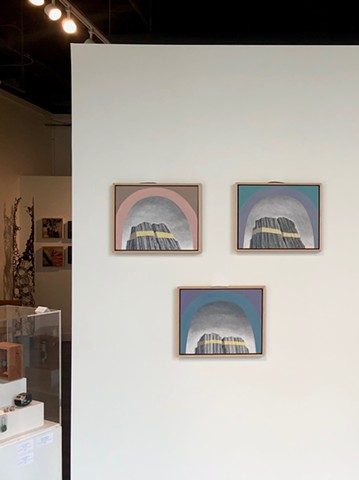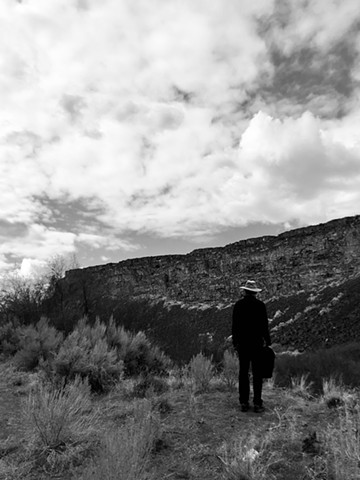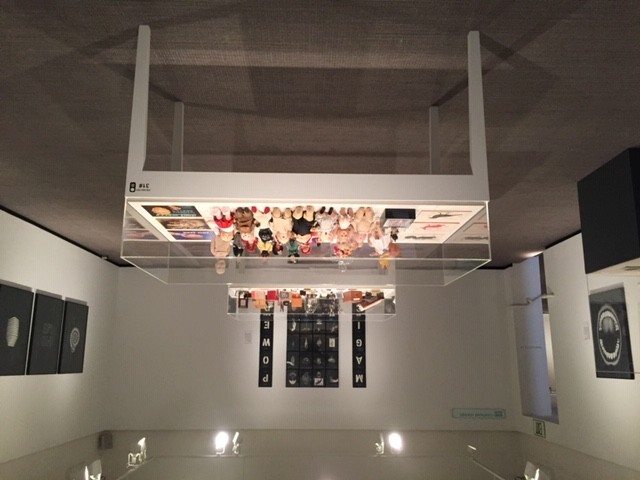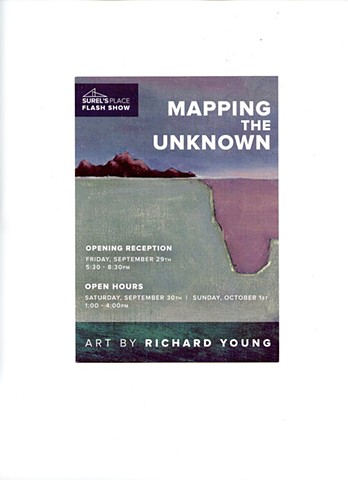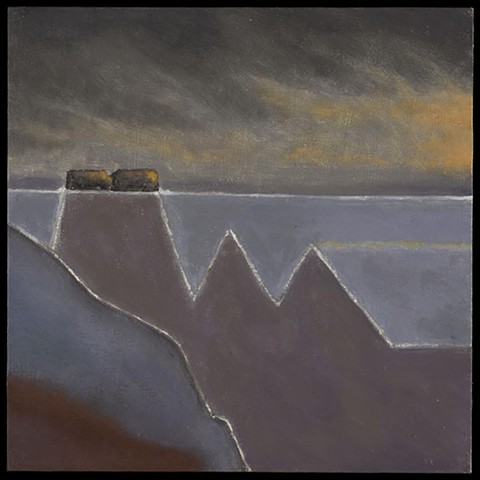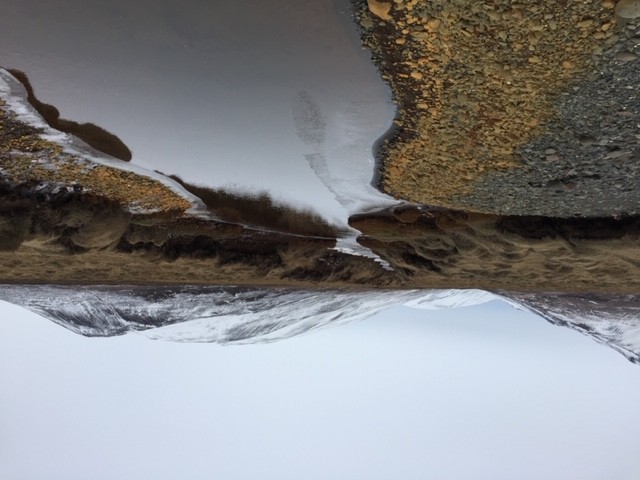Upcoming Exhibition, 2028: Herrett Museum, Twin Falls, Idaho.
Upcoming Exhibition 2027: Visual Arts Collective, Boise, Idaho
"Point of Origin" (1986) featured in current exhbition at Boise Art Museum
I am very pleased to announced that one of my paintings is featured in a current exhibition at Boise Art Museum. The exhibition drawn from BAMs Permanent Collection "highlights our shifting perspectives and connections with the land during a period of dramatic change and development". "Myths, Fables and Fortunes". "Point of Origin: (1986) oil and wax on canvas. 66 x 78"
"Passages" at The Art Museum of Eastern Idaho, August 1 - November 2023
A solo exhibition beautifully curated and arranged by Alexa Stanger, Executive Director of The Art Museum of Eastern Idaho. I would also like to thank the patrons of museum who came to the opening and stayed for the artists talk.
Richard Young and Sue Latta, Upcoming exhibition in August 2023 at Capital Contemporary Gallery in Boise, Idaho
I'm eternally grateful to all who attended the opening reception and artist's talk. I would also like to thank Sue Latta for delivering a superb and honest artist's talk.
Richard A. Young and Cassandra Schiffler at Capitol Contemporary Gallery in October 2022
Richard Young, Artist, Idaho Press, February 23, 2022
Richard Young has always been an artist.
Young is a local visual artist, who specializes in painting and mixed media art. He grew up in Detroit, Michigan, where his father was a graphic designer for Ford Motor Company. In a statement about his most recent exhibition, called “A Delicate Balance”, displayed at Boise State’s Blue Gallery from Jan. 18 to March 30, 2022, Young thanks his father for inspiring him as an artist, as a child and throughout his life.
Young’s current exhibition is made up of 45 works, both paintings and mixed media. He used photos he took himself, ink, collage, about 150 vintage metal printer plates, and numerous “found objects” to create complex, three-dimensional works.
“They’re puzzles in many ways,” Young said. “In a lot of ways it’s about the puzzle pieces that hold us together and make us who we are. And how complicated those puzzle pieces are and how sometimes they don't fit together or sometimes things happen that sort of affect the structure.”
Young created this exhibition, and much of his work in recent years, as an outlet through which he processed and reflected on his life.
“A lot of the work that I've done in the past couple of years has been more autobiographical, even though it's in more of a metaphoric language,” Young said. “One of the things that influenced that was the passing of my wife.”
Young and his wife, Cheryl Shurtleff, who was also an artist, both taught in the art department at Boise State University for many years.
He taught fine art, and served as art department chair in his time at Boise State. He was drawn to teaching because he discovered that in teaching, he also continued to learn about himself.
“I think that the type of education that you receive and that sort of nurturing of creativity is really important for everyone,” Young said.
Young has spent his career providing broader education and access to arts in Boise. He was a commissioner with the City of Boise Dept. of Arts and History, and was on the board at the Boise Art Museum, and his goal was always to advocate for artists.
“I've worked with a lot of people in the community, and there's some amazing people here that really continue to create a great environment for artists,” Young said.
He believes that art provides a powerful voice for those who want to address societal issues, and personal ones. He is excited to see Boise continue to grow in the opportunities and variety that it offers for artists, students, and the greater community.
“What I've always loved about Boise in particular is that it's a place to really make things happen,” Young said.
After completing his latest set of works, Young will take a break. Over the next few months he will slowly start to craft his next exhibition.
Balancing Act: Richard Young at the Blue Galleries, January- March 2022, by Christopher Schnoor
Over the course of the last couple of years Boise painter and mixed media artist Richard Young has given us sneak previews on Instagram of some of the works currently in his impressive one-man show at Boise State University’s Blue Galleries, located in the Center for the Visual Arts building. They did not prepare viewers for what was in store for them in the actual event.
Entitled “A Delicate Balance,” the 45-piece exhibition is part new work, part retrospective and covers a period when events in Young’s personal and professional life have had an ongoing impact on his art. It is a remarkable exhibit in terms of both scope and intensity, and allows us to witness the unfolding of new ideas, techniques and materials by this innovative, prolific artist. As former BSU Art Department Professor and Chair, for Young, who had a hand in making this extraordinary building a reality, it is, in a very real sense, a homecoming.
In 2018, Young retired from his professorship to devote himself fulltime to his art. Since then, his output has been prodigious. Two fortunate developments helped fuel a new burst of energy in the studio. In 2017, he was awarded a two-month long Artist-in-Residency grant in northern Iceland, an experience that had a major impact on his work. Coming as it did after the passing of his wife, artist Cheryl Shurtleff, this land of stillness and solitude opened his eyes and mind to a number of entwined dichotomies in nature and life, which, for Young, included “loss and recovery, equilibrium and flux, and past and present.” The give and take of geologic forces at play in Iceland inspired Young to recognize and explore the delicate balance of forces within his own interior terrains.
Secondly, Young had the good fortune of obtaining over 100 engraved metal printer’s plates mounted on wood blocks. This windfall of ghostly, anonymous yearbook photos and reproductions of buildings, places and things not only provided a gold mine of new material for Young to incorporate into his art, but opened up a new realm of aesthetic possibilities as well. It has facilitated the juxtaposing of, and interaction between, representational and abstract elements to achieve a three-dimensionality in his work, and expand beyond the boundaries of the square, flat surface of his plywood supports. Each work is no longer just a window to look through but an object in and of itself, intruding into our space.
This exhibition reveals the range of influences that have informed, and continue to inform his art, from landscape painting (particularly 19th century romanticism), to surrealism, to Josef Albers’ poetic “homages to the square,” and photography. His inclusion of found objects in his heretofore two-dimensional work perhaps suggests a Duchampian bent as well.
Upon entry to the exhibit the visitor is greeted by works from 2003. Young’s Pop Art-like sensibility is revealed in his ability to recognize the iconic possibilities in commercial products. In “Message from Detroit” and “Message from LA,” classic 1950s and ‘60s cars strike a grand pose in the advertising style of the day, while further down paintings of everyday tools and hardware are promoted to icon status as they share wood panels with Hudson River School-inspired landscape scenes.
Except for the 2003 works mentioned above, “A Delicate Balance” picks up from where Young left off after completing two bodies of paintings during and immediately following his sojourn in Iceland. In 2019-20 the tone of his art changes as he focuses more intensely on the themes of loss and grieving through the inclusion of his own photography and use of the printing blocks.
In a series of multi-media works collectively called “Passages,” Young turns his focus to photographing abandoned buildings, empty houses and deteriorating billboards with most of their advertising missing. These photographs, representing as they do futility and defeat, become, with the attached printing plates, the tangible equivalent of the idea of mourning and loss.
In one piece a sign introduces us to a town called Enigma which, given its reference to hidden meanings makes it an appropriate setting for such mixed media works as “Family Vacation 1, 2 and 3,” and the particularly poignant image of his elderly, bedridden mother in “To Jean,” the centerpiece of this grouping. Young’s combined mediums of photography and water-based oils, the inclusion of printing blocks with the images often obscured by wearing down or overpainting the plates with water-based oils, lends these images a faded-memories quality, and a haunting translucency.
In the larger of the two exhibition spaces, an entire wall is dedicated to Young’s mixed media work from 2019 through 2021, capturing the course of his art over this three-year period. There is a rhythm to this show revealed here, a contest between the negative and the positive that reflects the artist’s various ruminations embodied in this procession of forms, materials and imagery.
Young is very open to sharing aspects of his psyche and autobiography giving his art an intimacy we are unaccustomed to seeing these days. His inclusion of self-portraits, one entitled “Lineage,” the other also titled “A Delicate Balance” from 2021, are a case in point. In the second piece we witness a balancing act between vulnerability and contentment represented by the artist asleep inside a protective cocoon of abstract elements.
Along with the scenes of the dilapidated billboards there are other landscape works that also belong to this genre that could be called roadside romanticism. This is painting and photography that is inspired by the stretches of road we drive through and what we encounter there. Young’s old Gulf gas stations fall into this category as well. In the mixed media pieces “Red Square” (2020) and “Reconfigured” (2021), the artist captures an off-road, weather-beaten barn on the verge of collapse, leaning precariously to one side, a lonely structure under a threatening sky, at the mercy of the elements. They are moody, melancholy scenes. At the same time, there is “The Road Home” (2021), with its flat stretch of highway disappearing into the distance to a familiar destination with mixed feelings perhaps.
Concurrently, Young was making art like the seemingly ice-encrusted “Anonymous” whose painted and distressed photographic surface has an intriguing wintery beauty that stops us in our tracks.
But the strongest evidence of Young’s moving on from the past are the six new abstract paintings/collages installed on a wall by themselves. All but one are vertically formatted, and in them we see echoes of Mark Rothko’s rectangular color structures and, in two, Agnes Martin’s canvases of graphite pencil-line grids and striations. Particularly striking is “The Searchers,” with its photograph of a dark, subtle, reflected moonlight scene and collaged sheets of lined note paper overlaying painted panels. There is a wedding of two visions of the sublime here, combining romantic landscape and minimalism.
One cannot close without mentioning Young’s large mixed media work on finished wood, “A Gathering.” With its 20 printing blocks presenting yearbook photos of hopeful, innocent faces, it is in sharp contrast to the angry crowds that fill the news today, as was the artist’s intention. It is a thought-provoking critique of our times.
This diverse, moving and visually compelling show is up through the end of March.
One-Person Exhibition at Boise State University Blue Galleries, January 2022
"Still Lives" Richard Young and John Taye at Capitol Contemporary Gallery in Boise, Idaho March-April 2021
Richard Young and Judy Lombardi at Capitol Contemporary Gallery, Boise, Idaho 2020
Photo credit: Fonda Portales
Essay by Christopher Schnoor
LOST AND FOUND
Richard Young’s Rites of Passage
Boise artist Richard Young is, one could say, a man on a mission. The last five years have been a period of momentous change, necessitating a move toward to a new stage of his life, during which he has harnessed his art as an instrument of introspection and discovery. The impetus for embarking on this project was the passing of his wife, artist Cheryl Shurtleff, which was a turning point in and of itself, followed by the end of his academic career at Boise State University. In brief, the time was ripe for a recovery.
In 2016 Young retired from his university professorship and went on a two-month artist residency in arctic Iceland at a place called Skägastrond. With its slowed-down sense of time, stillness, and solitude it is an inspirational site, suited for reflection and exploration, literally a breath of fresh air after a time of stress and emotional pain. The local light and atmospherics also helped to create a temper that was conducive to contemplation.
Making art in such surroundings was a cathartic experience which, in hindsight, was something of a rite of passage. In a series of small-scale landscape paintings collectively titled Mapping the Unknown Young focused on the idea of loss and regeneration, a conjoined premise that resonated with him in this environment. Inspired by the local geology with it’s volcanic vistas, jagged peaks, islands of ice and rock, and icebergs floating in deep waters (both on and under the surface) he uncovered other antithetical dualities such as above and below, action and reaction, within and without, the hidden and the conspicuous, which now informed his art.
A subsequent group of works titled "Bridging the Gap" present imagined landscapes with contorted rivers heading nowhere and waterfalls that hang suspended like bath towels. Perhaps Young’s meandering ribbons of water and waterfall drapery hinted at a certain apprehension over where he and his art should go from here, a metaphor for the artist’s search for a place to reside aesthetically and philosophically in light of the recent past.
Following Bridging the Gap, Young embarked on a new body of work which in some respects can be seen as the offspring of the prior two projects. Titled Passages, this series of mixed-media paintings using his signature water-based oils and photography mark a move into broader territory subject-wise, revealing a realist sensibility replacing Young’s more romantic inclinations, i.e., urban settings substituting for the arcadian Arctic. Moreover, there is an intensity here of a sort that grabs you with its emotional overtones. A moodiness bordering on despair in these suggest a delving into more explicit interior landscapes, what this time could be called a “mapping the known.”
Working small-scale again (it is a format Young has generally preferred for some time) these post-residency pieces combine water-based oils, photography, and found objects and images that carry substantial personal baggage in their themes of mourning and loss. A case in point is the moving sepia-toned close up of his mother on her deathbed titled “To Jean”. In general, Passages reflects the duality of lost and found, manifest not only in the imagery but literally in the materials themselves. Young happened to score a collection of wood printer’s blocks transferred on which were sepias of anonymous yearbook photos, lined up along the margins of some of the pieces like ghostly visages salvaged from the past. In a sense it can be seen as a retrieval of lost souls.
This give and take between the past and the present is echoed in accompanying dark images of abandoned buildings and billboards. An example that ties these various components together is Young’s powerful triptych “Family Vacation.” (The title can be seen as a double entendre referring to either the circumstances under which the original photographs were taken, or read as having been vacated.) The center panel is of the artist’s bedridden mother, flanked on either side by examples of structural decline and loss. To the right is an abandoned Food Mart lurking in nighttime shadows in the center of which a doorway filled with light shines perhaps as a beacon of hope and regeneration. On the left, however, remnants of a billboard with only bits of lettering surviving, completes the picture of futility and defeat.
The billboard images lend a decadent ambience to the suburban settings, providing a counterweight to the faint yearbook figures Young sometimes incorporates. These man-made behemoths have a high-rise, commanding presence that dwarfs those on the ground. The long-legged “Ettes” stalks our world like something out of science fiction, while the towering “Configuration” evokes Shelley’s poem “Ozymandias” (“Look on my works, ye Mighty, and despair”), the ruins of an ancient conceit.
The impact of these mixed-media works is heightened by the knowledge that the subjects actually exist, captured on film and enhanced in paint. As a group, the billboards form a concatenation of mute monuments, united by their inability to communicate in any meaningful way except metaphorically. Young instills a real sense of drama to these structures; menacing despite their immobility and vacancy. It is now, with this out of his system, that he shifts gears and concludes Passages with a group of paintings in which a less grave melancholia resides.
Young is essentially a landscape artist. Although his portfolio includes figurative works and eccentric still lifes, for the most part the concept of landscape is, in its various incarnations, a central component of his oeuvre. And a major inspiration in this regard is the romantic movement in both its visual and literary art forms. The vistas by the 19th century Hudson River School, most notably Thomas Cole, and the paintings of German artist Caspar David Friedrich are important influences on his work. In a painting entitled “Skägastrond” in the Mapping the Unknown series Young depicts a dolmen, one of those massive prehistoric stones marking Neolithic graves that Friedrich discovered and included in some of his landscapes. Even the billboards have a dark, Edgar Allan Poe kind of romanticism to them. This aesthetic inclination on Young’s part comes to the fore in the newer works in Passages.
There is a genre in painting and photography you could call roadside romanticism. It is inspired by the stretches of empty grasslands we drive through in the mid- and far-west, with lonely abandoned buildings, rusting farm implements, time-worn signs peppered with gunfire. They stand as reminders of nature’s overpowering of man-made structures and machinery, products of the industrial revolution. A poignant example is Young’s mixed-media painting “Leaning This Way” in which a beaten-down barn sways to the side, its precarious posture communicating fragility in the face of the elements, emphasized by the slate sky filled with swirling clouds. (Youngs’ dark, ominous skies remind this New Yorker of those black weather fronts that appear over the city announcing an imminent deluge on a hot, humid summer day.) The building presents as a figurative structure standing in isolation on the edge of an empty field, an image that recalls the explicit loneliness of Andrew Wyeth’s “Christina’s World”. But it is also a warning message of pending desolation, that nature can turn on us at any time for our environmental sins.
In a second consideration of the looming climate crisis, Young makes use of another motif of this genre, that of the out-of-time roadside gas station with its forms and symbols that can conjure up our own memories. In “Cornered,” a solitary, weathered Gulf Oil sign stands at an intersection under rows of power lines symbolizing an antiquated petrol industry and infrastructure that we remain strapped to. Here, too, dark clouds gather to portend an impending (metaphorical) storm, the consequences of which are our inheritance. All of us, viewers and artist alike, are the ones who are cornered. Curiously, Young surrounds the central image with a framework of striking, rectilinear forms, in this case a Mondrian-esque mosaic. The contrast is a visually stimulating, almost kaleidoscopic effect.
In these paintings we find the themes of loss and passage of time still informing Young’s art. Throughout the Passages series Young’s ability to create indelible images imbued with a strong emotional component sets this art apart. His marriage of photography and water-based oils is well-suited for his purposes. The photo-sensitive medium in combination with the thinned paint allows the artist to achieve a subtle luminosity with translucent atmospherics that touch on the sublime.
These later mixed-media paintings left one wondering if Passages was coming to a close and there was a new direction in the offing, perhaps one in which more color and light prevail in a new iconography. Richard Young is a very prolific artist and restless soul who cannot stand still artistically. He is a master of the unexpected, surprising us and, one suspects, himself.Christopher Schnoor
May 2020
Reivew of exhibition (September 2019) titled "Passages" at Capitol Contemporary Gallery, Boise, Idaho
https://www.boiseweekly.com/boise/common-ground/Content?oid=19272819
Retrospective exhibition of work by Cheryl K. Shurtleff-Young at Boise Art Museum.
Cheryl K. Shurtleff-Young: The Road is Wider than Long.
September 30, 2017 - May 20, 2018Organized by Boise Art Museum, Nicole Herden, Curator of Art
Photo: Installation view.
Credit: Richard A. Young2017 Flash exhibition at Surel's Place, Artist Residency Program.
Over 40 painting, drawings and mixed media work were exhibited as part of a one-person exhibition titled "Mapping the Unknown".
"Upheaval: Diagram 4" from Surel's Place Flash Exhibition 2017
Artist Residency in Iceland
Photo credit: Richard Young
2017
I attended a two-month artist residency (April,May) at Nes in Skagastrond, Iceland. The project was supported by the Idaho Commission on the Arts, Department of Art, College of Arts and Sciences, Arts and Humanities Institute at Boise State University and the artist. 11 artists from throughout the world also participated in the residency.
Photo credit: Richard Young
Two paintings recently selected for publication
Two paintings were selected for the cover of the 10th Anniversary of the "Idaho Review."ISBN: 1520-8389
http://www.boiseweekly.com/boise/ten-years-of-the-idaho-review/Content?oid=1
Upcoming Group Exhibition (2009)
Three works were included in an exhibition titled "Homage to the Artists" organized by Ochi Gallery in Sun Vallery, Idaho.http://www.ochigallery.com/
December 31, 2009
